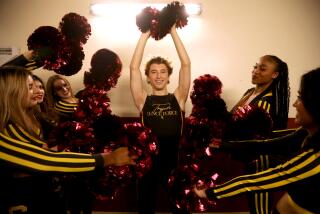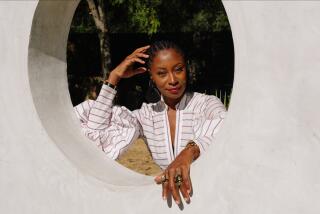South African creates dance for World Cup
- Share via
Reporting from Johannesburg, South Africa — The dance begins easily enough, with a knock-kneed jump. Then a series of soccer kicks, a sideways prance, a thrusting pump, a backward kick as your eyes follow an imaginary ball overhead. From there it gets complicated, until the final move, a diagonal kick, shooting for an imaginary goal.
It’s called the diski dance, named for the township slang for soccer, and it was created by Wendy Ramokgadi, a choreographer who as a boy dreamed of becoming the Michael Jackson of Soweto.
When the government tourism authority asked the 43-year-old to invent a dance for the 2010 World Cup, he fused his influences: Jackson, soccer and an energetic township dance called pantsula.
The idea is to feel the ball as you move: bouncing off your head, dancing around your ankles, cradled in the back of your neck, wobbling down your spine.
It looks difficult, but Ramokgadi says it’s not. He has taught it to thousands of people, from President Jacob Zuma down. He showed a stadium of 45,000 soccer fans at a match in Durban how to do it. He sent teams of diski dancers to the provinces to teach anyone they could find.
“If you are a pantsula dancer, it’s very easy to do,” he says.
And if you’re not?
“There’s nobody who can’t do the diski dance,” he says. “Sometimes I’ve even done it wearing a suit and tie.”
But Ramokgadi has had more practice than most.
When he was a boy, he spent hours mimicking Jackson’s moves in the “Thriller” video until he was almost perfect.
He had to dance alone. None of his friends was interested. But he had a rival.
“There was this guy at school who could do the Michael Jackson moves, and everyone started calling him Michael Jackson. I thought, ‘No, I deserve that. I must work harder.’”
It was the 1980s. Apartheid was grinding on violently. Nelson Mandela was in prison. And in the streets of Soweto, everyone was doing the pantsula. Until “Thriller” hit.
Ramokgadi got his break at 18 in Soweto’s Michael Jackson dance competition. Dozens of Michael Jacksons gyrated and pulsed across the stage. He won.
He formed a Michael Jackson dance group and became a regular on television and at shows. It was a most unlikely career for the son of a poor deliveryman and a cook. Ramokgadi became a professional choreographer.
He worked with many of South Africa’s musical greats and specialized in mass dance displays. In the early1990s, he created a dance for the hit song “Special Star” by the band Mango Groove.
Fast-forward to 2010, and the diski dance.
Ramokgadi says it typifies South Africa’s style. Brash, funny, cheeky, infectious, it was, like the vuvuzela, bound to catch on.
“The next thing you know, the whole world was getting into it and they were downloading it for free.”
More than 300,000 people have viewed his instructional clip on YouTube, and he’s planning an instructional CD. He was invited to Hong Kong to teach the dance to 2,000 people for a competition.
“In Hong Kong, they said, ‘Wendy, your dance is so complicated. We don’t think we’ll get it right.’ I said, ‘You are going to surprise yourselves. In 30 minutes, you are going to walk out that door, and you will be perfect.’
“First, you’ve got to imagine yourself playing soccer. Forget about everything else.
“Never lie to yourself and say, ‘I can’t do this.’ Listen to your heart. Your heart will never lie to you.”
He dreams that his dance will live on for South Africans beyond the World Cup.
“The diski dance has turned into our heritage,” he says. “It’s not just about the World Cup. It’s our own soccer dance. It’s going to be there for generations.”


